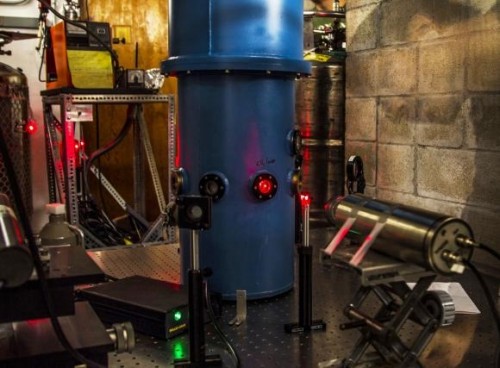Tag archives: quantum mechanics
Blockbuster physics, bowling balls and feathers in a vacuum, and more
By Tushna Commissariat
The results of a successful scientific experiment can make scientists very happy. Indeed, in the clip above, taken from the BBC TV series Human Universe, one scientist exclaims “holy mackarel!” when he sees the outcome he was hoping for. In the video, everybody’s favourite physicist Brian Cox carries out an experiment similar to Galileo’s Leaning Tower of Pisa experiment, where he tested that no matter the mass of objects, they fall at the same rate under gravity. In the video above, Cox drops a bunch of feathers and a bowling ball in the world’s biggest vacuum chamber – the Space Simulation Vacuum Chamber at NASA’s Space Power Facility in Ohio, US. In the slow-motion video, you can see with exquisite clarity just how accurate Galileo’s prediction was, as the feathers and ball land at precisely the same time. We came across this video on the Dot Physics blog on the Wired Science network, written by physicist Rhett Allain, where he has worked out some of the maths and pointed out some of the nuances of the above experiment, so make sure you take a look.
A 21st-century discourse on quantum mechanics and space–time
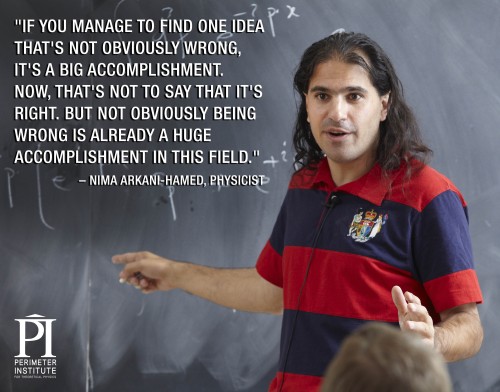
Revealing the secrets of space–time? (Courtesy: Perimeter Institute for Theoretical Physics)
By Tushna Commissariat
If you fancy a bit of late-night quantum mechanics, make sure that tonight you tune into the live webcast of “Quantum Mechanics and Spacetime in the 21st Century” – a lecture that by physicist Nima Arkani-Hamed as part of the Perimeter Institute’s Public Lecture Series. Arkani-Hamed, who won the inaugural Fundamental Physics Prize in 2012, says that he hasn’t “been this excited about physics in a very long time”. He will talk about how the most recent advances in quantum mechanics shed new light on our understanding of the universe’s fabric of time and space. In the past, Arkani-Hamed has shown how the weakness of gravity, compared with the other fundamental forces of nature, might be explained by the existence of extra dimensions of space. He has also recently been involved in the 2013 documentary Particle Fever, about the search for the Higgs boson.
The webcast will begin at 11.45 p.m. GMT (7 p.m. EST) and you can send questions to Arkani-Hamed by tweeting @Perimeter and using the hashtag #piLIVE. Take a look at a short teaser video for his talk below and tell us what you think about it in the comments section.
Can the electron wave function be trapped and divided?
By Hamish Johnston
Every once in a while we come across a physics story that seems very interesting – but we just don’t know what to make of it. The latest comes in the form of a press release from Brown University in the US and concerns “electron bubbles” in liquid helium.
These bubbles are about 4 nm in diameter and are formed when a free electron moves through liquid helium and repels surrounding atoms. Physicists have been studying these bubbles for decades and in the 1960s they discovered something very strange when firing electrons across a tank of liquid helium and measuring the time it takes the bubbles to reach a detector on the other side.
View all posts by this author | View this author's profile
Nobel mania – predictions, discussions, hangouts and more
By Tushna Commissariat
In this week’s Red Folder, we are looking at all things Nobel-prize-related, as the winner(s) of the 108th Nobel Prize for Physics will be announced in Stockholm next Tuesday.
Kicking off the Nobel round-up is our own infographic that tells you what branch of physics you should take up if you are keen to become a laureate yourself. In case you haven’t seen it already, take a look at it here and work your way through our seven categories that encompass all 107 physics Nobel prizes handed out to date.
Next, watch the video above where the Smithsonian Magazine’s science editor Victoria Jaggard hosts a Google Hangout to discuss the science and scientists predicted to win this year’s award. In it, she talks with Charles Day of Physics Today, Andrew Grant of Science News, Jennifer Ouellette of Cocktail Party Physics and Amanda Yoho of Starts With A Bang!, as they discuss everything from topological conductors to graphene to neutrinos.
View all posts by this author | View this author's profile
Fine-tuning quantum features to develop future technologies

Quantum kit: two superconducting qubits (left) and an artificial diamond with an NV centre (right). (Courtesy: Tushna Commissariat)
By Tushna Commissariat
I’ve left sunny Stockholm and I’m back at the office in blustery Bristol, but I still have a few good quantum tales to tell from the science-writers’ workshop at NORDITA last week. On Thursday, the main speaker of the day was Raymond Laflamme, who is the current director of the Institute for Quantum Computing at the University of Waterloo in Canada. Laflamme – who kick-started his career working on cosmology at the University of Cambridge in the UK as a student of Stephen Hawking – studies quantum decoherence and how to protect quantum systems from it by applying quantum error-correction codes, as well as using nuclear magnetic resonance (NMR) to develop a scalable method of controlling quantum systems.
View all posts by this author | View this author's profile
Reality is a concept you can apply to your cats
By Tushna Commissariat in Stockholm, Sweden
“Reality is a concept you can apply to your cats,” says Rainer Kaltenbaek to a room full of journalists and physicists, “so long as you don’t talk to Schrödinger.” Indeed, he warns us to not bother applying reality to anything that exists at the quantum level as we will just end up disappointed.
I am in Stockholm at a workshop for science writers being hosted at the Nordic Institute for Theoretical Physics (NORDITA) and the idea of completely forgetting “reality” is one of the many interesting things I have been pondering. Over the past two days we have discussed Bell’s loopholes, using your bathtub as an analogue laboratory to study black (and white) holes and learned about problems that even the best quantum computers (if they could be built) will not be able to solve.
Extraterrestrial espressos, quantum card-games, misunderstood science and more
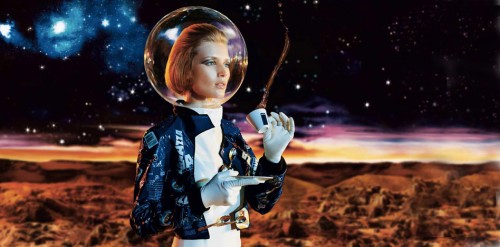
Mmm…ISSpresso in space. (Courtesy: Lavazza)
By Tushna Commissariat
Most of us can’t get our day started without a fortifying cup of coffee and astronauts are just the same. To help those on the International Space Station meet their caffeine cravings, Italian coffee king Lavazza has designed and built an espresso machine that will work in space! Called “ISSpresso” the machine will be blasted off into space in the possession of astronaut Samantha Cristoforetti, who will also be the first Italian woman in space. You can read all about the ISSpresso and its supreme blends on the Wired website.
Why electricity grids fail, what to do if your PhD is stolen, and what is a ‘Suris tetron’?
By Hamish Johnston
It’s the nightmare scenario for any PhD student: losing all those research results that you carefully squirreled away for when you finally sit down to write your thesis. That’s just what happened to biologist Billy Hinchen, who lost four years’ worth of 3D time-lapse videos of developing crustacean embryos when his laptop and back-up drives were stolen. Find out what happened next in “What would happen if you lost all of your research data?” by Julia Giddings at the scientific software firm Digital Science. Hinchen also tells his tale of woe in the video above.
View all posts by this author | View this author's profile
Five celebrities who are quantum physicists in disguise
By James Dacey
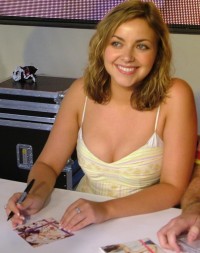
(CC-BY Keven Law)
This week the Welsh pop star Charlotte Church (right) has released her latest EP entitled Four. In a conversation with New Scientist, Church explained that the EP’s opening track “Entanglement” was in fact named after the quantum-mechanical phenomenon known affectionately to physicists as “spooky action at a distance”. She has since told BBC Wales that she may well take her interest in science to the next level by studying for a physics degree.
There are of course several really famous people who are more directly connected with physics, having studied the subject in some form before going on to become luminaries in other fields. Examples include the Queen guitar-god Brian May, and arguably the most powerful woman in the world the German chancellor Angela Merkel. But Church is one of a new brigade of celebrities who are discovering the joys of physics after having already reached stardom for other abilities. The armchair psychologist might suggest that learning about the mechanics of the cosmos offers a refreshing alternative to the shallow nature of life that often comes with the celebrity lifestyle, or at least our view of it as presented by the media.
Golden-anniversary physics, flaming challenges, smart lists and more
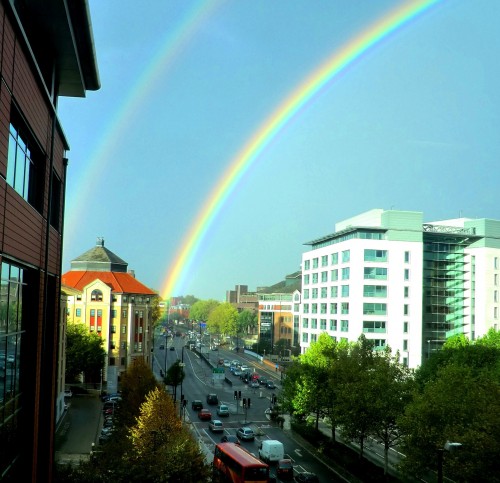
How do you explain the science behind a rainbow to a child?
By Tushna Commissariat
It never rains but it pours, they say, and 1964 experienced quite a downpour of amazing “physics firsts” as the first papers about quarks, the Higgs mechanism and the EPR paradox or Bell’s inequality were all published. Also, Arno Penzias and Robert Woodrow Wilson made their first measurement of the cosmic microwave background on 20 May 1964, detecting the whisper of the Big Bang. To celebrate 50 years since these world-changing discoveries were made, the Harvard-Smithsonian Centre for Astrophysics has produced a webcast (you can watch the video on their YouTube page in a week’s time) featuring leading cosmologists Alan Guth, Robert Woodrow Wilson, Robert Kirshner and Avi Loeb. You can read more about it in this fascinating article by David Kaiser on the Huffington Post website, as he take a deeper look at the eventful year of 1964.
